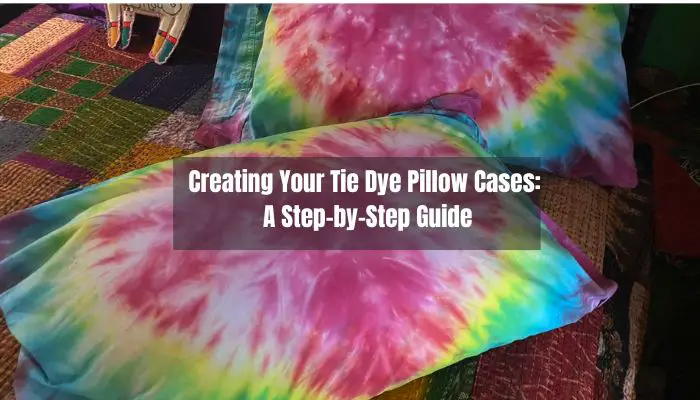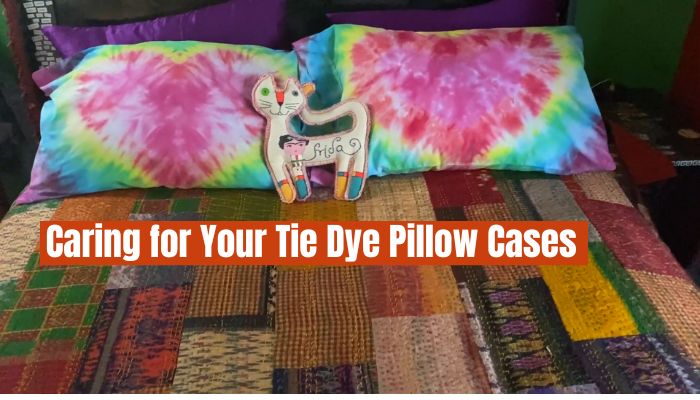Discover the colorful world of tie-dye pillowcases! From trending styles and DIY techniques to their cultural significance, dive into this vibrant craft. Click to unravel the rainbow!
What are Tie Dye Pillows Cases?
Tie-dye pillowcases are unique pieces of home décor that showcase vibrant and often psychedelic color patterns, achieved through the age-old art of tie-dyeing. A testament to individuality, each tie-dye pillow case carries a unique design, providing a riot of colors that can illuminate any room or living space.
The History of Tie Dye: A Colorful Past
Tie-dye, an art form that traces back over a thousand years, boasts a rich and colorful past. Originating in regions of India, Japan, and Africa, tie-dye has long been used to create beautiful and intricate designs on textiles. Ancient techniques have influenced modern methods, resulting in various styles and patterns that speak volumes of our shared global culture.
The 1960s: When Tie Dye became a Symbol of Counterculture
Tie-dye emerged during the 1960s, evolving into a symbol of counterculture and the free-spirited ethos of the decade. During this peace, love, and freedom era, tie-dye became synonymous with the “flower power” movement. Iconic artists and performers sported tie-dye outfits, and the trend quickly found its way into homes through colorful and expressive tie-dye pillowcases.
Trending Styles in Tie Dye Pillow Cases
In recent years, tie-dye pillowcases have resurfaced as trending home décor items. Let’s delve into some popular styles that are making waves in the market.
Psychedelic Swirls: A Classic
An enduring classic, the psychedelic swirl pattern continues to captivate with its vibrancy. Swirls of color radiate from the center, creating an explosion of hues that evoke a sense of creativity and joy. Psychedelic swirl pillowcases infuse your living space with a lively, retro vibe.
The Modern Shibori: Japanese Influence
Shibori, a traditional Japanese method of dyeing cloth, has profoundly impacted modern tie-dye designs. The modern Shibori tie-dye pillowcases exhibit a stunning blend of traditional craftsmanship and contemporary aesthetics. This style features a rich interplay of light and dark, making each pillowcase an artistic statement piece.
Ombré Tie Dye: The Subtle Elegance
Ombré tie-dye pillowcases are for those who appreciate subtlety. They feature a beautiful gradient effect, transitioning from a dark shade at one end to a lighter one at the other. This smooth progression of color lends an air of sophistication and understated elegance to these pillowcases.
Tie-dye pillowcases, with their captivating history and versatile styles, truly bring a splash of color and uniqueness to your home. Whether you want to add a pop of color to your living room or seek a visually engaging accent piece for your bedroom, tie-dye pillowcases offer many possibilities.
Remember, each tie-dye pillow case is a celebration of individuality and creativity. Just as no two tie-dye patterns are the same, no two homes should be. Allow these vibrant pieces to tell your story, and let your home reflect your unique spirit.
Why Tie Dye Pillow Cases are Making a Comeback
Tie-dye pillowcases are experiencing a resurgence in popularity, a trend fueled by a collective desire for personal expression and uniqueness in home décor. With their vibrant colors and captivating designs, tie-dye pillowcases contrast the mass-produced, often uniform styles of many modern interiors. Their comeback signifies a yearning for authenticity and individuality amid a digital and standardized world.

Creating Your Tie Dye Pillow Cases: A Step-by-Step Guide
Why not create your tie-dye pillowcases to personalize your living space further? Although it takes some time and persistence, the procedure is enjoyable, inventive, and surprisingly easy.
Supplies Required for Tie-Dyeing
You will require the following supplies to begin your tie-dye journey:
- White cotton pillowcases
- Fabric dye in your chosen colors
- Rubber bands
- Plastic squeeze bottles
- Plastic bags
- Rubber gloves
- Cold water
- Mild laundry detergent
The Tie Dye Process Explained
You are prepared to start the tie-dyeing process now that you have your materials.
- Your pillowcases should be pre-washed to get rid of any finishes that can obstruct the dyeing procedure.
- Choose your preferred tie dye pattern (e.g., spiral, bullseye, stripes) and use the rubber bands to secure your pillowcase in that pattern.
- Mix your dye with water in the squeeze bottles, following the manufacturer’s instructions.
- Wearing your rubber gloves, apply the dye to the pillowcases, making sure to get it into all of the layers of the fabric.
- Allowing the pillowcases to sit for at least six to eight hours will allow the dye to set once you are satisfied with the colors and pattern.
- After the rubber bands are taken off, rinse the pillowcases in cold water until the water is clear.
- Wash your newly dyed pillowcases separately in mild laundry detergent, then dry them as usual.
Caring for Your Tie Dye Pillow Cases
Tie-dye pillowcases, like any other dyed fabric, require careful handling to maintain their vibrant colors and unique designs. Always wash them separately in cold water with a mild detergent for the first few washes. Avoid bleach and harsh cleaning agents that may fade the colors. For drying, opt for air drying when possible to further preserve the vibrancy of your tie-dye.
By creating and caring for your tie-dye pillowcases, you’re not just adding unique pieces to your home decor but participating in an ancient art form that celebrates color, individuality, and the joy of creativity.

The Environmental Impact of Tie Dyeing
While tie dyeing is an artistic practice that celebrates individuality and creativity, it is essential to consider its environmental impact. Traditional dyeing processes can contribute to water pollution due to the discharge of untreated wastewater. However, as responsible consumers, we can purchase tie-dye pillowcases made with eco-friendly, non-toxic dyes. Alternatively, creating your tie dye designs at home allows for using natural plant dyes, offering a sustainable and environmentally friendly option.
Tie Dye Pillow Cases: More than Just a Trend
Tie-dye pillowcases are more than just a fleeting trend. They symbolize an appreciation for craftsmanship, color, and creative expression. By integrating tie-dye pillowcases into your home decor, you’re endorsing the artistry and skill that goes into each unique design. Moreover, these vibrant pieces serve as visual reminders of the beauty of diversity and the power of individual expression.
Inspiring Tie Dye Pillow Case Designs
Tie-dye pillowcases come in a multitude of designs that can inspire and uplift. From the intense and mesmerizing psychedelic swirls to the subtle elegance of ombré gradients, there’s a design for every aesthetic. Modern interpretations of the Japanese Shibori technique offer intricate, indigo-drenched patterns, while bold, geometric tie-dye designs create a contemporary and chic look. Each design tells a unique story, embodying the spirit of the tie-dye tradition while adding a vibrant touch to your living space.
Read more about How to Wrap a Pillow For a Gift? – Wrapping Guide
Conclusion: Adding a Splash of Color to Your Home with Tie Dye Pillow Cases
In conclusion, tie-dye pillowcases are more than just decorative items. They are artistic expressions, each unique, infused with a rich history, and imbued with personal significance. Their vibrant colors and dynamic patterns bring life to any room, acting as a focal point or a complementary accent depending on your home decor style. By choosing tie-dye pillowcases, you’re not just adding a splash of color to your home; you’re embracing a global art form, celebrating individuality, and expressing your unique style.
